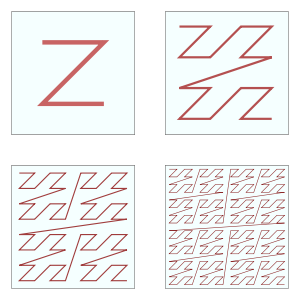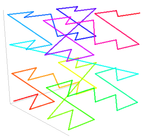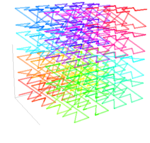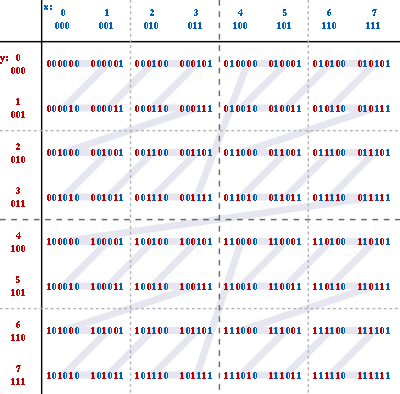
Z-order (curve)
Encyclopedia



Mathematical analysis
Mathematical analysis, which mathematicians refer to simply as analysis, has its beginnings in the rigorous formulation of infinitesimal calculus. It is a branch of pure mathematics that includes the theories of differentiation, integration and measure, limits, infinite series, and analytic functions...
and computer science
Computer science
Computer science or computing science is the study of the theoretical foundations of information and computation and of practical techniques for their implementation and application in computer systems...
, Z-order, Morton order, or Morton code is a space-filling curve
Space-filling curve
In mathematical analysis, a space-filling curve is a curve whose range contains the entire 2-dimensional unit square...
which maps multidimensional data to one dimension while preserving locality of the data points. It was introduced in 1966 by G. M. Morton. The z-value of a point in multidimensions is simply calculated by interleaving the binary
Binary code
A binary code is a way of representing text or computer processor instructions by the use of the binary number system's two-binary digits 0 and 1. This is accomplished by assigning a bit string to each particular symbol or instruction...
representations of its coordinate values. Once the data are sorted into this ordering, any one-dimensional data structure can be used such as binary search tree
Binary search tree
In computer science, a binary search tree , which may sometimes also be called an ordered or sorted binary tree, is a node-based binary tree data structurewhich has the following properties:...
s, B-tree
B-tree
In computer science, a B-tree is a tree data structure that keeps data sorted and allows searches, sequential access, insertions, and deletions in logarithmic time. The B-tree is a generalization of a binary search tree in that a node can have more than two children...
s, skip list
Skip list
A skip list is a data structure for storing a sorted list of items using a hierarchy of linked lists that connect increasingly sparse subsequences of the items...
s or (with low significant bits truncated) hash table
Hash table
In computer science, a hash table or hash map is a data structure that uses a hash function to map identifying values, known as keys , to their associated values . Thus, a hash table implements an associative array...
s. The resulting ordering can equivalently be described as the order one would get from a depth-first traversal of a quadtree
Quadtree
A quadtree is a tree data structure in which each internal node has exactly four children. Quadtrees are most often used to partition a two dimensional space by recursively subdividing it into four quadrants or regions. The regions may be square or rectangular, or may have arbitrary shapes. This...
; because of its close connection with quadtrees, the Z-ordering can be used to efficiently construct quadtrees and related higher dimensional data structures.
Coordinate values
The figure below shows the Z-values for the two dimensional case with integer coordinates 0 ≤ x ≤ 7, 0 ≤ y ≤ 7 (shown both in decimal and binary). Interleaving the binary coordinate values yields binary z-values as shown. Connecting the z-values in their numerical order produces the recursively Z-shaped curve.
Efficiently building quadtrees
As mentioned above, the Z-ordering can be used to efficiently build a quadtree for a set of points. The basic idea is to sort the input set according to Z-order. Once sorted, the points can either be stored in a binary search tree and used directly, which is called a linear quadtree, or they can be used to build a pointer based quadtree.The input points are usually scaled in each dimension to be positive integers, either as a fixed point representation over the unit range [0, 1] or corresponding to the machine word size. Both representations are equivalent and allow for the highest order non-zero bit to be found in constant time. Each square in the quadtree has a side length which is a power of two, and corner coordinates which are multiples of the side length. Given any two points, the derived square for the two points is the smallest square covering both points. The interleaving of bits from the x and y components of each point is called the shuffle of x and y, and can be extended to higher dimensions.
Points can be sorted according to their shuffle without explicitly interleaving the bits. To do this, for each dimension, the most significant bit of the exclusive or of the coordinates of the two points for that dimension is examined. The dimension for which the most significant bit is largest is then used to compare the two points to determine their shuffle order.
The exclusive or operation masks off the higher order bits for which the two coordinates are identical. Since the shuffle interleaves bits from higher order to lower order, identifying the coordinate with the largest most significant bit, identifies the first bit in the shuffle order which differs, and that coordinate can be used to compare the two points. This is shown in the following Python code:
def cmp_zorder(a, b):
j = 0
k = 0
x = 0
for k in range(dim):
y = a[k] ^ b[k]
if less_msb(x, y):
j = k
x = y
return a[j] - b[j]
One way to determine whether the most significant smaller is to compare the floor of the base-2 logarithm of each point. It turns out the following operation is equivalent, and only requires exclusive or operations :
def less_msb(x, y):
return x < y and x < (x ^ y)
It is also possible to compare floating point numbers using the same technique. The less_msb function is modified to first compare the exponents. Only when they are equal is the standard less_msb function used on the mantissas.
Once the points are in sorted order, two properties make it easy to build a quadtree: The first is that the points contained in a square of the quadtree form a contiguous interval in the sorted order. The second is that if more than one child of a square contains an input point, the square is the derived square for two adjacent points in the sorted order.
For each adjacent pair of points, the derived square is computed and its side length determined. For each derived square, the interval containing it is bounded by the first larger square to the right and to the left in sorted order. Each such interval corresponds to a square in the quadtree. The result of this is a compressed quadtree, where only nodes containing input points or two or more children are present. A non-compressed quadtree can be built by restoring the missing nodes, if desired.
Rather than building a pointer based quadtree, the points can be maintained in sorted order in a data structure such as a binary search tree. This allows points to be added and deleted in O(log n) time. Two quadtrees can be merged by merging the two sorted sets of points, and removing duplicates. Point location can be done by searching for the points preceding and following the query point in the sorted order. If the quadtree is compressed, the predecessor node found may be an arbitrary leaf inside the compressed node of interest. In this case, it is necessary to find the predecessor of the least common ancestor of the query point and the leaf found.
Use with one-dimensional data structures for range searching
Although preserving locality well, for efficient range searches an algorithm is necessary for calculating, from a point encountered in the data structure, the next Z-value which is in the multidimensional search range:
UB-tree
The UB-tree as proposed by Rudolf Bayer and Volker Markl is a balanced tree for storing and efficiently retrieving multidimensional data. It is basically a B+ tree with records stored according to Z-order, also called Morton order...
s ("GetNextZ-address"). As the approach does not depend on the one dimensional data structure chosen, there is still free choice of structuring the data, so well known methods such as balanced trees can be used to cope with dynamic data (in contrast for example to R-tree
R-tree
R-trees are tree data structures used for spatial access methods, i.e., for indexing multi-dimensional information such as geographical coordinates, rectangles or polygons. The R-tree was proposed by Antonin Guttman in 1984 and has found significant use in both research and real-world applications...
s where special considerations are necessary). Similarly, this independence makes it easier to incorporate the method into existing databases.
Applying the method hierarchically (according to the data structure at hand), optionally in both increasing and decreasing direction, yields highly efficient multidimensional range search which is important in both commercial and technical applications, e.g. as a procedure underlying nearest neighbour searches. Z-order is one of the few multidimensional access methods that has found its way into commercial database systems (Oracle database
Oracle database
The Oracle Database is an object-relational database management system produced and marketed by Oracle Corporation....
1995, Transbase 2000 ).
As long ago as 1966, G.M.Morton proposed Z-order for file sequencing of a static two dimensional geographical database. Areal data units are contained in one or a few quadratic frames represented by their sizes and lower right corner Z-values, the sizes complying with the Z-order hierarchy at the corner position. With high probability, changing to an adjacent frame is done with one or a few relatively small scanning steps.
Related structures
As an alternative, the Hilbert curveHilbert curve
A Hilbert curve is a continuous fractal space-filling curve first described by the German mathematician David Hilbert in 1891, as a variant of the space-filling curves discovered by Giuseppe Peano in 1890....
has been suggested as it has a better order-preserving behaviour, but here the calculations are much more complicated, leading to significant processor overhead. BIGMIN source code for both Z-curve and Hilbert-curve were described in a patent by H. Tropf.
For a recent overview on multidimensional data processing, including e.g. nearest neighbour searches, see Hanan Samet's textbook.
Applications in linear algebra
The Strassen algorithmStrassen algorithm
In the mathematical discipline of linear algebra, the Strassen algorithm, named after Volker Strassen, is an algorithm used for matrix multiplication...
for matrix multiplication is based on splitting the matrices in four blocks, and then recursively each of these blocks in four smaller blocks, until the blocks are single elements (or more practically: until reaching matrices so small that the trivial algorithm is faster). Arranging the matrix elements in Z-order then improves locality, and has the additional advantage (compared to row- or column-major ordering) that the subroutine for multiplying two blocks does not need to know the total size of the matrix, but only the size of the blocks and their location in memory. Effective use of Strassen multiplication
with Z-order has been demonstrated, see Valsalam and Skjellum's 2002 paper.
See also
- UB-treeUB-treeThe UB-tree as proposed by Rudolf Bayer and Volker Markl is a balanced tree for storing and efficiently retrieving multidimensional data. It is basically a B+ tree with records stored according to Z-order, also called Morton order...
- Hilbert curveHilbert curveA Hilbert curve is a continuous fractal space-filling curve first described by the German mathematician David Hilbert in 1891, as a variant of the space-filling curves discovered by Giuseppe Peano in 1890....
- Hilbert R-treeHilbert R-treeHilbert R-tree, an R-tree variant, is an index for multidimensional objects like lines, regions, 3-D objects, or high dimensional feature-based parametric objects. It can be thought of as an extension to B+-tree for multidimensional objects....
- Spatial index
- locality preserving hashingLocality preserving hashingIn computer science, a locality preserving hashing is a hash function f that maps a point or points in a multidimensional coordinate space to a scalar value, such that if we have three points A, B and C such that|A-B|...
- Matrix representationMatrix representationMatrix representation is a method used by a computer language to store matrices of more than one dimension in memory.Fortran and C use different schemes. Fortran uses "Column Major", in which all the elements for a given column are stored contiguously in memory...
- Linear algebraLinear algebraLinear algebra is a branch of mathematics that studies vector spaces, also called linear spaces, along with linear functions that input one vector and output another. Such functions are called linear maps and can be represented by matrices if a basis is given. Thus matrix theory is often...
External links
- STANN: A library for approximate nearest neighbor search, using Z-order curve
- Methods for programming bit interleaving, Sean Eron Anderson, Stanford University

